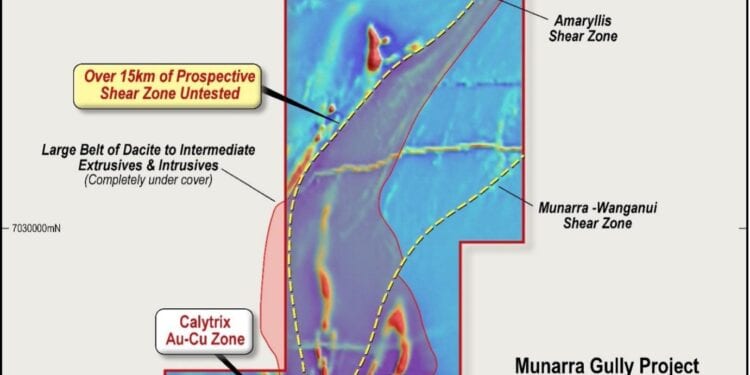Preparing To Undertake Further Work On 2.3km Amaryllis Prospect
Rumble Resources Ltd (ASX: RTR) has defined a large-scale gold-copper-silver system over 2.3km in strike in association with a major north-south trending shear system named the Amaryllis Prospect located on the Munarra Gully Project near Cue in the Murchison Goldfields of Western Australia.
results and interpretation from the latest reconnaissance RC drilling and mapping programme completed at the Amaryllis Prospect located on the Munarra Gully Project near Cue in the Murchison Goldfields of Western Australia.
The Amaryllis Shear zone lies within E51/1919 and E51/1927 owned 100% by Rumble which forms part of the Munarra Gully Project.
Armed with results and interpretation from the latest reconnaissance RC drilling and mapping programme completed at the Amaryllis Prospect Rumble has defined a large-scale gold-copper-silver system over 2.3km in strike (completely open) under shallow cover (10 to 40m) in association with a major north-south trending shear system.
The 2300m of strike has been partly tested by Rumble on relatively wide spacing. Recent regional reconnaissance exploration which involved mapping and relogging all available historic drill-holes has inferred the highly mineralised regionally extensive Amaryllis shear zone extends over 15km to the north under cover untested by drilling.
The current round of reconnaissance RC drilling comprised of 20 drill holes for 3121m and was designed to:
- Extend the gold-copper-silver mineralisation north along strike
- Extend the copper dominant mineralisation (Calytrix) with respect to strike and plunge potential.
- Test four (4) EM conductors (Moving Loop ground TEM survey completed by Rumble).
Approximately 500m north and along strike from the known Amaryllis mineralisation a single RC drill hole traverse (section 7025200N) tested gold and copper anomalism associated with shallow historic AC drilling.
Multiple perched supergene gold blankets (>100ppb Au) over 200m in width were delineated at a depth below 50m. Below and within the supergene zones, a wide zone of altered and sheared porphyritic dacite intrusive returned multiple gold intersections including:
- 8m @ 1.06 g/t Au from 80m (4m composites)
- 4m @ 4 g/t Au from 112m (4m composite)
- 8m @ 0.7 g/t Au from 64m (4m composites)
- 4m @ 3.39 g/t Au from 119m (1m sampling)
Beneath 20m of transported cover, basement rocks are strongly weathered and depleted of metal above the supergene gold zones.
RC drilling has extended > 1% Cu (Au-Cu-Ag) mineralisation further north along strike. The newly named Calytrix zone is over 350m in strike open in both directions and down dip. Results include:
• 5m @ 1.16% Cu, 0.78 g/t Au, 16.2 g/t Ag from 109m
o Within broad zone – 28m @ 0.36% Cu, 0.42 g/t Au, 5.4 g/t Ag from 108m.
• 2m @ 1.49% Cu, 0.81 g/t Au, 18 g/t Ag from 108m
o Within broad zone – 35m @ 0.26% Cu, 0.32 g/t Au from 75m
Over a strike 350m (open), >1% Cu and > 1 g/t Au intersections highlight strong continuity of mineralisation in predominantly intensely sheared porphyritic dacitic high level intrusives. Mineralisation is completely open down dip. Transported cover is generally less than 20m. Within the zone of mineralisation, deep weathering (80 to 100m vertical) has attributed to significant depletion of gold and copper in the upper saprolite profile.
Multiple perched palaeo-water tables are prevalent within the highly weathered basement. Late acidic and saline groundwaters from nearby Lake Annean have likely remobilised and redistributed both gold and copper into broad pervasive supergene zones in the oxide zone.
Based on the comparative style of mineralisation with respect to Chibougamau Au Cu Deposit types, i.e. strong dip component to ore deposits, lesser strike component, Rumble will complete a down- hole TEM survey within the Calytrix zone to affirm if there is a conductive response from the known pyrite-chalcopyrite-pyrrhotite mineralisation.
Follow up diamond drilling targeting higher tenor mineralisation (based on conductance). This will allow: Structural information – currently lacking due to no historic diamond drill core available and Mineralisation and host characterisation.











